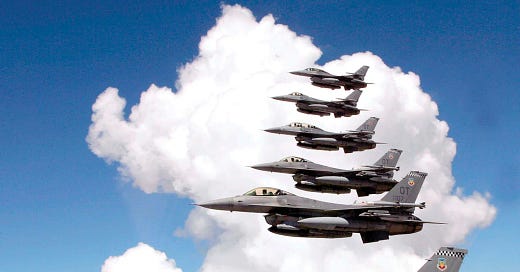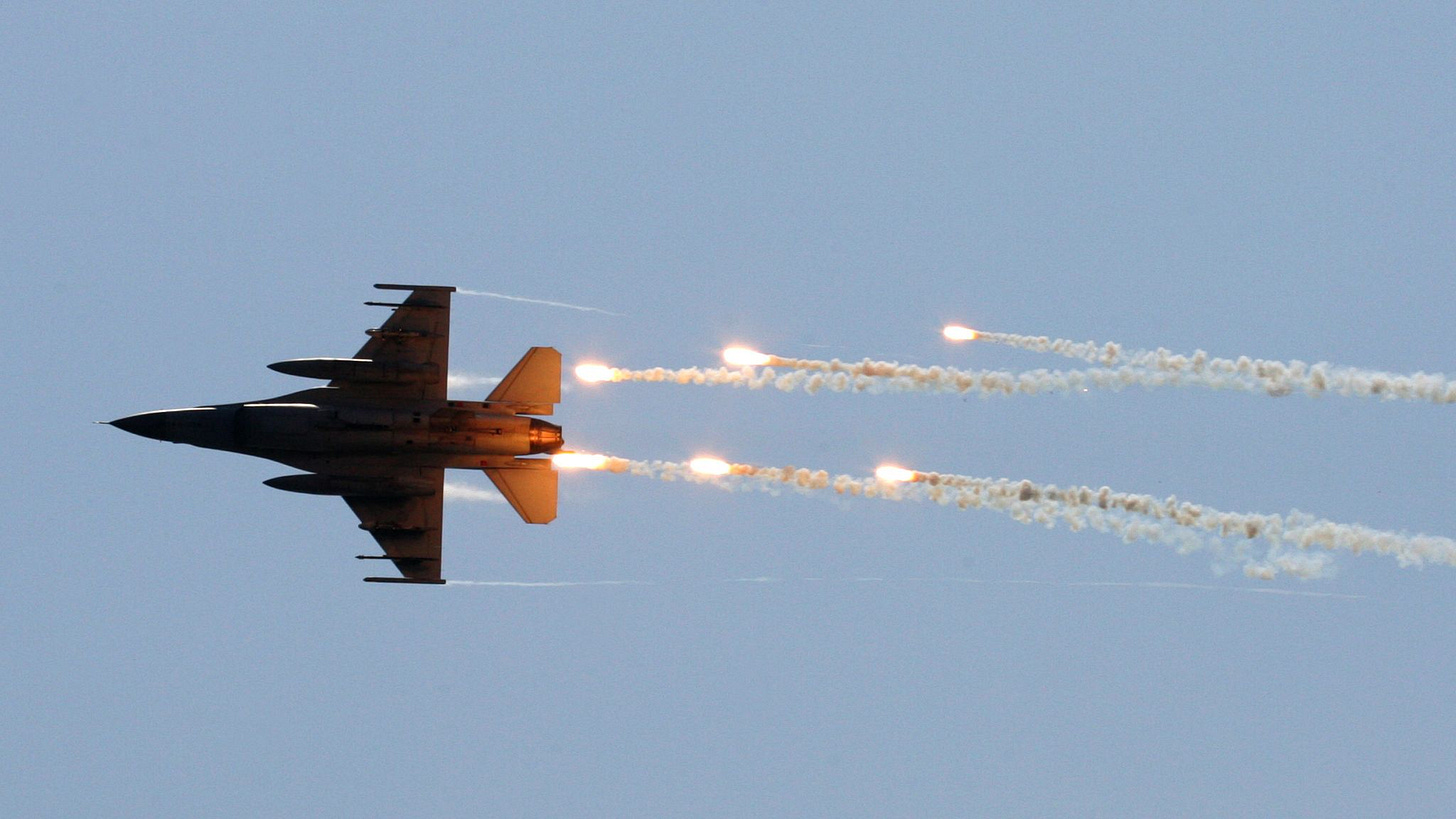US to send F-16 Fighter Jets to Ukraine
Day after Biden approves training for Ukrainian pilots on US-made jets, Russia’s deputy foreign minister accuses Western countries of ‘still adhering to the escalation scenario’
US National Security Advisor Jake Sullivan told reporters at the G7 summit in Japan that Biden “informed his G7 counterparts that the United States will support a joint effort to train Ukrainian pilots on fourth generation fighter aircraft including F-16s.” He added the US “will work with our allies to determine when planes will be delivered, who will be delivering them and how many.”
When exactly Ukraine will receive the fighter jets — and which countries will be assisting in providing them — remains unclear, but the official said the planes would not be used for Ukraine's upcoming counteroffensive against Russia. In the coming months, the U.S. and its allies “will decide when to actually provide jets, how many we will provide, and who will provide them,” the official said. This news just came after President Joe Biden on Friday informed leaders of leading industrialized nations that the U.S. will support efforts to train Ukrainian pilots on F-16s.
The move by US President Joe Biden was welcomed by the UK, Netherlands, Belgium and Denmark. On Friday, Prime Minister Rishi Sunak tweeted: "The UK will work together with the USA and the Netherlands, Belgium and Denmark to get Ukraine the combat air capability it needs. We stand united."
Colin Kahl, the Pentagon's top policy official, previously told Congress that training Ukrainian pilots on F-16s could take “about 18 months.” Other U.S. defense officials have said the training could be shortened to only six to nine months based on pilots' previous training and knowledge of fighter aircraft. In his appearance before the House Armed Services Committee, Kahl said that it could cost up to $11 billion to revitalize Ukraine's military with F-16 jets.
What is the F-16?
The F-16 Fighting Falcon is a lightweight fighter aircraft that was initially designed in the 1970s. It first went into service in 1979, and was used heavily by the US Air Force in both Iraq wars and in Afghanistan.
Originally built by the US in a consortium with Belgium, Denmark, the Netherlands and Norway, the jet, which can travel twice the speed of sound, became one of the most popular military aircraft of all time and remains in wide use. Lockheed Martin, the US manufacturer, says there are more than 3,000 F-16s in service in 25 countries.
Its payload typically consists of two 2,000lb (907kg) bombs, two AIM-9 Sidewinder short-range air-to-air missiles, two AIM-120 medium-range air-to-air missiles and two 2,400lb (1,088kg) external fuel tanks.
Although first fielded decades ago, the F-16 has been continuously updated and remains one of the most capable, complex and deadly weapons systems in the world. With a range of more than 500 miles, it is capable of fielding the Joint Air-to-Surface Standoff Missile, with a range of up to 1,200 miles. These weapons threaten both Moscow and St. Petersburg.
The Ukrainians have repeatedly asked for the supply of Western fighter jets to replace its dwindling stock of ex-Soviet MiG-29s and Su-27s, which have seen extensive use since the beginning of the full-scale invasion in February 2022 and have suffered significant combat attrition. Ukraine has lost “over 60” aircraft, top U.S. Air Force Gen. James B. Hecker said at a conference in Colorado on March 6. Reacting to the British and Dutch announcements, Andriy Yermak, a key Zelensky aide, said, “We need F-16s, and I am grateful to our allies for their decision to work in this direction, including training our pilots.”
According to Russia’s state-owned news agency Tass, the country’s deputy foreign minister, Alexander Grushko, said: “We see that western countries are still adhering to the escalation scenario. It involves colossal risks for themselves. In any case, this will be taken into account in all our plans, and we have all the necessary means to achieve the goals we have set.”
The announcement that NATO would send F-16 fighters to Ukraine takes place in flagrant defiance of multiple explicit promises made by the Biden administration to the public, aimed at reassuring the population that it was seeking to avoid an escalation of a full-scale war with nuclear-armed Russia.
In March 2022, Biden asserted, “the idea that we’re going to send in offensive equipment and have planes and tanks and trains going in with American pilots and American crews, just understand—and don’t kid yourself, no matter what you all say—that’s called World War Three.” It’s clear the Biden administration has begun to fall back on these statements. Or completely disregard that they even made these comments to begin with.
Biden stated in May, “We will not be directly engaged in this conflict, either by sending American troops to fight in Ukraine or by attacking Russian forces. We are not encouraging or enabling Ukraine to strike beyond its borders.”
Biden has continued to cross his own “Red Lines” he and his own administration have set forth to limit their involvement in the War in Ukraine.
In January, the Biden administration announced that it would send dozens of M1 Abrams main battle tanks to Ukraine, alongside hundreds of other main battle tanks from NATO countries.
In April, leaked documents revealed that 97 NATO special operations troops are deployed inside Ukraine, alongside 71 active-duty US military personnel. These troops, according to an article published this week in the in the Wall Street Journal, are “operating very close to the front lines” and are a “guiding influence on Ukrainian special-forces activity.” It been clear since the release of the Leaked Files and the recent comments from Biden, The United States wanted to keep this as a low profile proxy war. But it’s been proven now that we are fully involved in being Ukraines number one ally in this War with Russia.
The latest sanctions aimed at Russia include tighter restrictions on already-sanctioned people and firms involved in the war effort. More than 125 individuals and organizations across 20 countries have been hit with U.S. sanctions. The financial penalties have been primarily focused on sanctions evaders connected to technology procurement for the Kremlin. The Commerce Department also added 71 firms to its own list.
Treasury Secretary Janet Yellen said the Friday sanctions “will further tighten the vise on Putin’s ability to wage his barbaric invasion and will advance our global efforts to cut off Russian attempts to evade sanctions.”
In addition, new reporting requirements were issued for people and firms that have any interest in Russian Central Bank assets. The purpose is to “fully map holdings of Russia’s sovereign assets that will remain immobilized in G7 jurisdictions until Russia pays for the damage it has caused to Ukraine,” the U.S. Treasury Department said. Russia is now the most-sanctioned country in the world, but there are questions about the effectiveness.
Congress must be formally notified and given an opportunity to object to allowing the F-16 third-party transfers, a step the administration has not yet taken. The time limit for congressional response to notification is shortened, from 30 to 15 days, if the country asking for approval is a NATO member or a handful of other close defense allies.
While some lawmakers have objected to the flow of tens of billions of dollars of U.S. weaponry, support for Ukraine is still broad and deep in Congress, where some members have specifically urged Biden to move on F-16s. Paths to block the decision are limited to the passage of legislation specifically prohibiting the move, or of a veto-proof resolution of disapproval in the House and Senate.
The G7 nations said in Friday’s statement that they would work to keep Russia from using the international financial system to prosecute its war, and they urged other nations to stop providing Russia with support and weapons “or face severe costs.”
In conclusion, this recent announcement signifies a critical shift in US policy towards Ukraine. President Biden's decision to aid in the training of Ukrainian pilots on F-16s – despite not yet defining the specifics of this support – marks an important step in strengthening Ukraine's defenses. This move, while welcomed by several allies, comes with significant implications, including an escalation in tensions with Russia.
Yet, the path ahead is filled with uncertainty. How the US will navigate its previous statements regarding non-escalation, and how this policy shift will be received by Congress are pivotal in the unfolding scenario. Further, the effectiveness of the increased economic sanctions on Russia remains to be seen.
As the G7 nations rally to keep Russia from exploiting the international financial system for its war efforts, the world watches keenly. This complex global issue is far from resolution and continues to evolve. The role of the United States, while controversial, is undoubtedly crucial in this unfolding narrative. Time will tell how these developments contribute to the prospects of peace and stability in the region.





